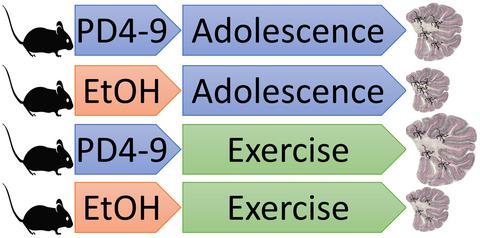当前位置:
X-MOL 学术
›
Int. J. Dev. Neurosci.
›
论文详情
Our official English website, www.x-mol.net, welcomes your feedback! (Note: you will need to create a separate account there.)
Postnatal alcohol exposure and adolescent exercise have opposite effects on cerebellar microglia in rat
International Journal of Developmental Neuroscience ( IF 1.8 ) Pub Date : 2020-08-04 , DOI: 10.1002/jdn.10051 Zachary H Gursky 1 , Julia R Johansson 1 , Anna Y Klintsova 1
International Journal of Developmental Neuroscience ( IF 1.8 ) Pub Date : 2020-08-04 , DOI: 10.1002/jdn.10051 Zachary H Gursky 1 , Julia R Johansson 1 , Anna Y Klintsova 1
Affiliation

|
Developmental alcohol exposure results in altered neuroimmune function in both humans and rodents. Given the critical role for the principle neuroimmune cell, microglia, in maintaining synaptic form and function, microglial dysfunction in the cerebellum may be an important mechanism underlying the aberrant cerebellar connectivity observed in rodent models of fetal alcohol spectrum disorders. Using an established rodent model of alcohol exposure during human third‐trimester fetal development, we examine the cerebellum of male and female Long Evans rats to determine the impact of early postnatal alcohol exposure on cerebellar microglia, and the potential therapeutic effects of an adolescent intervention consisting of voluntary exercise (running). All cerebelli were examined at postnatal day 42 (i.e., late adolescence), and microglia were labeled with Iba1, a microglia‐specific protein. Early postnatal alcohol exposure caused an increase in microglial density throughout cerebellum and a reduction in cerebellar volume, and a reduction in the proportion of fully ramified (often called “resting state”) microglia selective to lobules 1–4. In contrast, adolescent exercise decreased microglial density throughout cerebellum and increased cerebellar volume, while activating microglia (as indicated by increases in amoeboid microglia, and reductions in fully and partially ramified microglia) selectively in lobules 1–4. These results suggest that adolescent exercise may be a suitable intervention to ameliorate alcohol‐induced neuroimmune dysfunction as it alters microglia density and cerebellar volume in opposite to the effects of developmental alcohol exposure. Importantly, exercise intervention can be flexibly implemented well after the time window of vulnerability to alcohol.
中文翻译:

产后酒精暴露和青少年运动对大鼠小脑小胶质细胞的影响相反
发育性酒精暴露导致人类和啮齿动物的神经免疫功能发生改变。鉴于主要神经免疫细胞小胶质细胞在维持突触形式和功能方面的关键作用,小脑中的小胶质细胞功能障碍可能是在胎儿酒精谱系障碍啮齿动物模型中观察到的小脑连接异常的重要机制。使用已建立的人类妊娠晚期胎儿发育期间酒精暴露的啮齿动物模型,我们检查了雄性和雌性 Long Evans 大鼠的小脑,以确定产后早期酒精暴露对小脑小胶质细胞的影响,以及青少年干预的潜在治疗效果,包括自愿锻炼(跑步)。所有小脑在出生后第 42 天(即青春期晚期)进行检查,和小胶质细胞用小胶质细胞特异性蛋白 Iba1 标记。产后早期酒精暴露导致整个小脑的小胶质细胞密度增加和小脑体积减少,以及对小叶 1-4 具有选择性的完全分支(通常称为“静息状态”)小胶质细胞的比例减少。相比之下,青少年运动降低了整个小脑的小胶质细胞密度并增加了小脑体积,同时选择性地激活了小叶 1-4 中的小胶质细胞(如变形虫小胶质细胞的增加以及完全和部分分支的小胶质细胞的减少)。这些结果表明,青少年运动可能是改善酒精引起的神经免疫功能障碍的合适干预措施,因为它会改变小胶质细胞密度和小脑体积,与发育性酒精暴露的影响相反。
更新日期:2020-08-04
中文翻译:

产后酒精暴露和青少年运动对大鼠小脑小胶质细胞的影响相反
发育性酒精暴露导致人类和啮齿动物的神经免疫功能发生改变。鉴于主要神经免疫细胞小胶质细胞在维持突触形式和功能方面的关键作用,小脑中的小胶质细胞功能障碍可能是在胎儿酒精谱系障碍啮齿动物模型中观察到的小脑连接异常的重要机制。使用已建立的人类妊娠晚期胎儿发育期间酒精暴露的啮齿动物模型,我们检查了雄性和雌性 Long Evans 大鼠的小脑,以确定产后早期酒精暴露对小脑小胶质细胞的影响,以及青少年干预的潜在治疗效果,包括自愿锻炼(跑步)。所有小脑在出生后第 42 天(即青春期晚期)进行检查,和小胶质细胞用小胶质细胞特异性蛋白 Iba1 标记。产后早期酒精暴露导致整个小脑的小胶质细胞密度增加和小脑体积减少,以及对小叶 1-4 具有选择性的完全分支(通常称为“静息状态”)小胶质细胞的比例减少。相比之下,青少年运动降低了整个小脑的小胶质细胞密度并增加了小脑体积,同时选择性地激活了小叶 1-4 中的小胶质细胞(如变形虫小胶质细胞的增加以及完全和部分分支的小胶质细胞的减少)。这些结果表明,青少年运动可能是改善酒精引起的神经免疫功能障碍的合适干预措施,因为它会改变小胶质细胞密度和小脑体积,与发育性酒精暴露的影响相反。


























 京公网安备 11010802027423号
京公网安备 11010802027423号